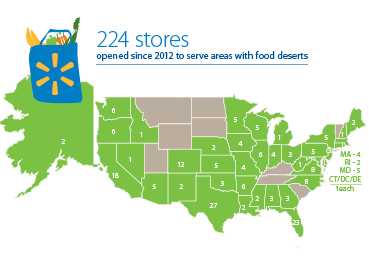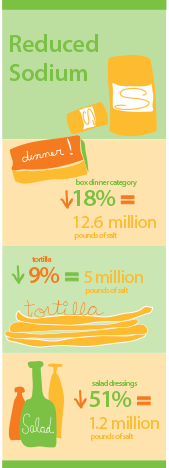Social
Making it easier to eat healthier
With millions of customers shopping in our stores around the world each week, we provide easy access to affordable, healthier food. In January 2011, we made five public commitments aimed at leveraging our business and philanthropic resources to make healthier eating easier in the U.S. We look forward to learning from this initiative and exploring how we might translate this work around the world.

Great For You™
Walmart committed to creating and implementing a front-of-pack icon to help customers quickly and easily identify more nutritious foods. In 2013, our Great For You™ icon continued to roll out on private-brand foods and beverages across all of our Walmart U.S. stores.
- More than 30 percent of qualifying items, including fresh produce, meats, poultry, seafood, and Great Value™ and Marketside™ private-brand packaged foods and beverages now carry the Great For You™ icon.
- We launched tools to help consumers put Great For You™ into action. These include more than 75 quick, affordable and nutritious recipes, weekly food tips, messages communicated via social media channels and a series of short videos to help families plan, shop and prepare healthier meals and snacks at home.
- In 2013, the Great For You™ icon was made available for use by national brand companies.
Savings
Walmart promised to save customers $1 billion annually on produce. In FY2014, we exceeded that promise by saving customers $1.2 billion on fruits and vegetables in the U.S. Since making this commitment, we have saved customers $3.5 billion on fresh produce. We also maintain a list of more than 500 food items, paired with their better-for-you version. In 2011, a better-for-you item generally cost 5.7 percent more than the traditional version, but was reduced to 5.4 percent in FY2013. For FY2014, that price premium was further reduced to 5.1 percent.
Access
Walmart committed to opening 275 to 300 new stores in areas serving food deserts by 2016. The 2010 U.S. Census showed an increase in areas defined as food deserts. Following this new definition, we’ve opened 224 stores in areas serving food deserts across the country. Of these, 48 were opened in FY2012, 80 in FY2013 and 96 in FY2014.
Reformulation


In 2011, we committed to reducing sugars and sodium, and eliminating industrially produced trans fats in products carried in our stores. This five-year commitment, which focuses on our combined Great Value™, Marketside™ and nationally branded portfolios, runs through the end of 2015 and uses baseline data starting in 2008.
By the end of 2015:
- Walmart committed to a 25 percent sodium reduction. Currently, our sodium reduction achieved stands at 13 percent, halfway to our goal.
- Walmart committed to eliminating industrially produced trans fats from all private- and national-brand products. At the end of FY2013, fewer than 7 percent of products in our U.S. stores contained hydrogenated oils, a decrease from 9 percent in FY2012.
- Walmart committed to reducing sugars by 10 percent across the products it sells. The company exceeded this goal in 2012 and continues to realize further reductions in select grocery categories.
Nutrition education
Walmart and the Walmart Foundation continue to honor our commitment to increase charitable support for nutrition programming, donating more than $15.4 million in 2013 and more than $41 million since 2011. With a goal of helping Americans learn to choose and use healthier, more nutritious food items, we fund programs that teach cooking and shopping skills, provide nutrition education and increase knowledge of healthy eating.
In 2013, the Walmart Foundation funded programs that aim to reach more than 1.1 million individuals. For example:
- $1.3 million grant to Institute for America’s Health to provide nutrition education to 64,000 students and teachers.
- $2.5 million grant to Share Our Strength’s Cooking Matters program to help more than 107,500 low-income individuals learn cooking and shopping skills.
